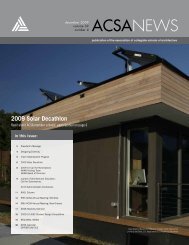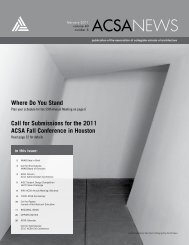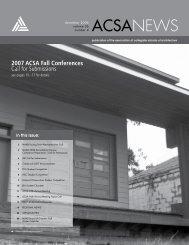digital aptitudes - Association of Collegiate Schools of Architecture
digital aptitudes - Association of Collegiate Schools of Architecture
digital aptitudes - Association of Collegiate Schools of Architecture
You also want an ePaper? Increase the reach of your titles
YUMPU automatically turns print PDFs into web optimized ePapers that Google loves.
SATURDAY, MARCH 3, 2012 - 12:30PM - 2:00PM<br />
<strong>Architecture</strong> Continued<br />
Small House<br />
Donna Kacmar, University <strong>of</strong> Houston<br />
This 544 sq. ft. house was placed at the back <strong>of</strong> a large lot to allow<br />
for future development if desired while also sized to allow for<br />
house to be moved if property was sold for land value only. The<br />
house sits next to a large carport/porch and looks out to a large<br />
Ipe deck and the lawn beyond. The house is efficiently designed for<br />
a couple who spend much <strong>of</strong> their time away but required a place<br />
near work and family. The house is wrapped in low maintenance<br />
metal siding on the exterior and simple materials are used inside.<br />
The bathroom and closet are clad in vintage white oak siding that<br />
matches the kitchen cabinetry and refers to the cabin like quality<br />
<strong>of</strong> this very modest home.<br />
Structural Scents<br />
Glenn Nowak, University <strong>of</strong> Nevada, Las Vegas<br />
Erik Swendseid, Univeristy <strong>of</strong> Nevada, Las Vegas<br />
The Structure <strong>of</strong> Scent<br />
An examination <strong>of</strong> past developments between design and human<br />
interaction will generate the NEXT pedagogical intersection between<br />
architecture and society; the next point in which designers<br />
educate and inform society <strong>of</strong> the experiential qualities <strong>of</strong> a fulfilling<br />
built environment.<br />
Throughout the last 100 years, society’s vastly changed perception<br />
<strong>of</strong> color, light, scale, sound, movement, and technology in design<br />
and architecture has forever altered the way we live in and<br />
judge our built environment. This heightened sense <strong>of</strong> awareness<br />
has either redefined or given each element a new role as a layer<br />
in the designer’s thought process. Their combined syntheses with<br />
all other elements <strong>of</strong> design have led to groundbreaking creativity<br />
and innovation in architecture. We now see buildings that are<br />
covered with light that dance to music. Information technology has<br />
made possible a whole new level <strong>of</strong> complexity and human interaction<br />
with architecture. Advances in engineering and the science <strong>of</strong><br />
materials have allowed architects to design bigger and taller, while<br />
keeping users safer. Architectural visualizations and architectural<br />
acoustics have made tremendous strides over the last one hundred<br />
years. With such advances happening in the way architecture engages<br />
our emotions and physical environment, we can argue the<br />
thought that the olfactory sense will, in the next 100 years, mimic<br />
these advancements and employ a much more critical role in our<br />
sensory experience.<br />
Given its potential cognitive capacity, a heightened sense <strong>of</strong> olfactory<br />
awareness will enable us to do more than merely enjoy a<br />
pleasant amenity, but instead will provide us with a tool for living.<br />
Educating ourselves <strong>of</strong> this potential, learning the “language” <strong>of</strong><br />
scent, and taking advantage <strong>of</strong> its benefits will deliver only richer<br />
experiences in design. Today, the way we perceive scent and<br />
translate its meaning <strong>of</strong>ten leaves us describing it in very elementary<br />
terms such as “good“ or “<strong>of</strong>fensive“. With such an effort in<br />
society to cover one scent with another scent, we <strong>of</strong>ten fail to<br />
recognize the many subtleties in between an under whelmed and<br />
overwhelmed environment. Being able to express and recognize<br />
gradations in scent will allow designers to use scent as a tool for<br />
design, to communicate specific goals to the end user, and will<br />
allow the olfactory sense to become a more functional piece <strong>of</strong><br />
everyday life, as opposed to something with which we currently<br />
use to simply recognize decoration. With advances in perfuming<br />
science, scientists can not only create new smells that have never<br />
been recognized before in nature, but they can pinpoint the exact<br />
molecular structure for these and all other scents in order to arrive<br />
at a specific purpose for design.<br />
As designers, we need to seize the opportunity and potential <strong>of</strong> all<br />
senses in design, while taking into account the complexity <strong>of</strong> the<br />
human mind and its multidimensional and multisensory comforts<br />
to insure that they do not become dormant in an unchallenging<br />
society. “The architecture <strong>of</strong> tomorrow will call for an architect that<br />
can embed new kinds <strong>of</strong> rules and design behaviors together with<br />
design ingenuity.” Maria Lorena Lehman<br />
The Fibrous Structure Machine: a Generative Process<br />
Towards Form-Finding<br />
Emmanouil Vermisso, Florida Atlantic University<br />
The project discussed here was developed during a six week research<br />
& design seminar on biologically inspired prototyping<br />
(the project itself lasting four weeks). Based on the observation<br />
that nature produces infinite structural and formal configurations<br />
through re-cycling <strong>of</strong> only one material (fibers), a ‘machine’ was<br />
designed that would fabricate complex shapes using a variety <strong>of</strong><br />
thread types and a simple actuator such as a Lego® motor. The<br />
project is regarded as an attempt to learn from the efficiency <strong>of</strong><br />
biological systems; in the long-term, the authors would like to extract<br />
a series <strong>of</strong> ‘rules’ from the properties <strong>of</strong> the three fiber types<br />
that exist in the human body. We are interested in this line <strong>of</strong> study<br />
because it operates on both formal (aesthetic) and performative<br />
(functional) levels. The nature <strong>of</strong> the work involved requires input<br />
from other disciplines like Engineering to perform analysis on the<br />
resulting prototypes which is something that we are encouraging<br />
as a working methodology. From an Architectural standpoint, the<br />
next generations <strong>of</strong> this machine can provide a good platform for<br />
developing some sort <strong>of</strong> structural response to form. The precedence<br />
for this investigation seems to be assuming an ever-growing<br />
importance within the context <strong>of</strong> integration in <strong>Architecture</strong> and<br />
the authors believe that such premises will constitute a large portion<br />
<strong>of</strong> future Design -related research.<br />
Thick-It<br />
Adam Fure, University <strong>of</strong> Michigan<br />
Global climate change and the imperative <strong>of</strong> sustainability have<br />
placed immense pressure on the discipline to consider innovation in<br />
new terms. Technological progress is no longer measured solely by<br />
advancements in structural engineering, responsive skins, and new<br />
composite materials but also by the responsible recycling, renewal,<br />
and reuse <strong>of</strong> that which already exists. Until now advancements<br />
in computation and <strong>digital</strong> fabrication have been predominately<br />
in service <strong>of</strong> the former while material scientists and a handful <strong>of</strong><br />
resourceful architects have propelled the latter. Thick-It expands<br />
the role <strong>of</strong> computation in sustainable material practice by mixing<br />
high-tech <strong>digital</strong> protocols with low-tech material realities.<br />
Digital Apptitutes + Other Openings - Boston, MA - 39








